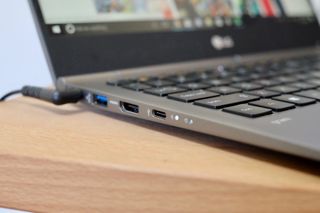Why you can trust TechRadar
The Intel Core i5 processor inside the gram 13 isn’t the fastest available, especially at this price point. And, with Intel’s HD Graphics 620 chip, the gram 13 isn’t built for gaming.
That’s not to say you can’t enjoy the occasional gaming session, though you may have to lower resolution and detail settings or deal with lower frame rates.
The Full HD (1080p) display is commonplace and does its job. It’s appreciated to see LG offer a 256GB SSD and 8GB RAM as a starting point for the gram 13, with additional upgrades available.
Starting $300 less than this gram 13, the Dell XPS 13 can be configured with comparable specs to offer nearly identical performance for about the same price. That said, the LG gram 13 lasted far longer in our battery tests.
Here’s how the LG gram 13 performed in our suite of benchmark tests:
3DMark Sky Diver: 1,336; Fire Strike: 313; Time Spy: 327
Cinebench CPU: 326 points; Graphics: 38.17 fps
GeekBench: 3,065 (single-core); 6,706 (multi-core)
PCMark 8 (Home Test): 2,427 points
PCMark 8 Battery Life: 5 hours and 52 minutes
Battery Life (TechRadar movie test): 9 hours and 11 minutes
Performance
Looking at the gram 13’s benchmark scores, it’s clear this laptop isn’t the fastest device. That said, in real world use, overall performance wasn’t noticeably slow.
There were times when opening an application after a restart took longer than it should have, or so it seemed. But, once applications were up and running, any sluggishness was negligible.
Gaming or video editing will push the gram 13 to its limits, but there’s enough computer under the hood to at least tinker with video editing and gaming.
If you are someone who frequently works with video or wants to get more serious with gaming, the Dell Inspiron 15 Gaming is a budget gaming device done right.

Wobbly screen
During our time testing the LG gram 13, the touchscreen was commonly used for scrolling and selecting items on the display. The screen itself was responsive, and accurately recognized touches without issue.
It’s the amount of give in the hinge, which sees the screen wobbling and shaking with every touch, that eventually becomes a distraction.
Often, we would hold one side of the screen with one hand while simultaneously touching the screen with the other. That shouldn’t be something any user has to do on a touchscreen device, ever.

Flexible in a not-so-good way
It may sound weird, but trust us: When you squeeze the gram 13’s housing, it feels empty. The gram 13 fails to invoke any feeling of a premium device, in terms of build quality. In other words, the frame gives a lot – perhaps too much – flex.
Grabbing the HP Spectre 13 in a similar fashion has a bit of flex, but it’s nothing like what we’ve experienced with the gram 13.
Obviously, the inside of the gram 13 isn’t empty, but one has to wonder how well a housing that bends when barely squeezed will hold up to being banged around in a backpack or an accidental tumble off of a desk.

Battery life
LG’s marketing material claims 15 hours of use on battery due to optimizations made by the company, along with a power-saving mode when the battery gets low. While our results are far under that promise, they’re still far better than most Ultrabooks we’ve tested.
TechRadar’s movie benchmark test resulted in 9 hours and 11 minutes of continuous playback with screen brightness and audio set to 50% as well as all radios but Wi-Fi disabled. The PCMark 8 Battery Test clocked in at 5 hours and 52 minutes under the same conditions.
Neither result is horrible, with the likes of the XPS 13 giving out nearly two hours before the gram 13 did.
Using the gram 13 during regular work hours, we were able to get through nearly a full, 8-hour day of mixed use consisting of the occasional YouTube video, Microsoft’s Mail app open and always running, as was Slack and Facebook and Google Play Music streaming sweet tunes.
Again, this longevity is mighty impressive, but it is a far cry from the 15 hours LG is promising customers. And, before you ask, yes, we left the power saving mode enabled during our regular use.

We liked
The LG gram 13’s fingerprint sensor is an indispensable feature that makes the switch back to PIN codes or passwords ever so difficult. It’s far from a workhorse, but more than powerful enough – and portable enough – for students. The thin screen bezels are also welcome, and, of course, the battery life is longer than most Ultrabooks we’ve tested thus far.
We disliked
But, calling a spade a spade, our battery tests fall well short of the expectations LG sets in marketing guides – the same materials customers rely on when making a purchase decision. Using alternative materials to evoke a premium feel or go lighter than the competition only gets you so far; in this case, all one needs to do is pick up the LG gram 13 to realize that.
Final verdict
The LG gram 13 looks like a premium device on the price tag and from afar. Unfortunately, the mirage falls apart once you unbox it. Sure, it’s light and easy to tote around, but the build quality leaves us wanting something much better.
The Intel Core i5 processor offers enough power, when combined with the 8GB of RAM, to have multiple tabs open in Chrome while researching a topic. But, it’s not going to cut it for the most demanding of users.
If portability, strong battery life, and a fingerprint sensor are three key items on your laptop checklist, then the LG gram 13 is worth checking out. On the flip side, if buying a device that feels like it’s built to last is anywhere on your list of required features, we would look elsewhere.

The obscure little PC that wanted to be a big NAS — super compact Maiyunda M1 doesn't cost that much, offers up to 40TB SSD storage, runs Windows and has 4 Gigabit Ethernet ports

Image site Abload going offline reminds me of how much online content we've permanently lost

Gemini's next evolution could let you use the AI while you browse the internet
